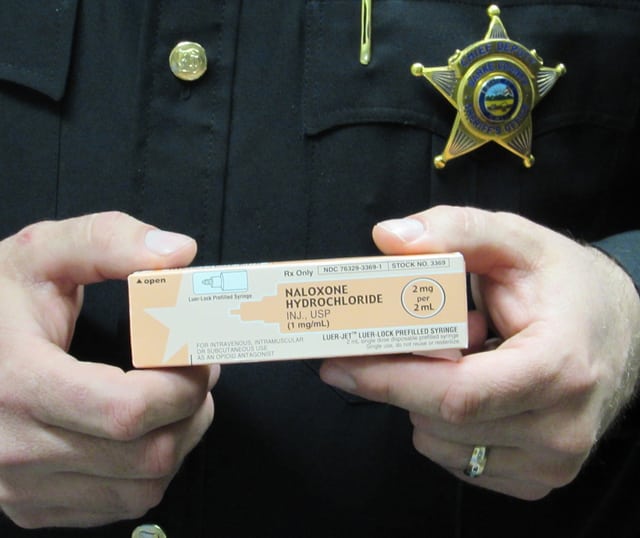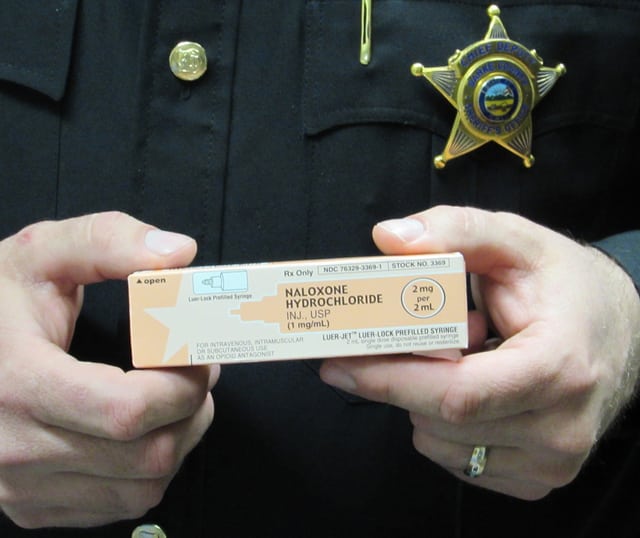

DARKE COUNTY — Deputies with the Darke County Sheriff’s Office have a new, potentially life-saving tool at their disposal.
Narcan, the trade name for the drug Naxolone, is a medication used to block the effects of opioids, such as heroin. When administered to a person who has overdosed, Narcan can help revive the person until he or she receives medical attention.
Darke County Chief Deputy Mark Whittaker said each of the Darke County Sheriff’s patrol vehicles is now equipped with two doses of Narcan. Each dose is 2-milligrams and includes a shaped nose-piece for spraying the substance into each of an overdose victim’s nostrils.
“We’ve implemented a Narcan policy and procedure,” he said. “We’ve also provided training to all the patrol deputies. Also included in that training are deputies that work in the jail. Eventually, before it’s all said and done, the Sheriff’s Patrol Auxiliary members will be provided training.”
Narcan isn’t the only life-saving equipment deputies have on hand. Patrol vehicles are equipped with an Automated External Defibrillator (AED) and a first-aid kit, which includes masks for Cardiopulmonary Resuscitation (CPR).
Whittaker, who served as a paramedic before becoming a sheriff’s deputy, now in his 2oth year, admits that law enforcement carries a lot more in the way of medical equipment than when he started.
“We do, we carry a lot of stuff,” he said. “It’s become necessary. It doesn’t surprise me that we’ve reached this point. The technology and science, as far as what we can do to provide assistance to people medically, has become advanced. Enough studies have been done that we recognize that there are certain skills that are not near as hard as we thought they would be one day.”
“When I was a paramedic years ago, we gave Narcan, but we gave it through an I.V. or an I.M. in the form of a shot,” he added. “It was considered an advanced technique. But now…Narcan can be sprayed up the nose, so it’s really easy and have the same life-saving effects, in the form of an aerosol. And you don’t have to be an EMT or paramedic to do that.”
Ohio law now provides law enforcement with legal authority to administer Narcan.
“Prior to that, it was a controlled substance. You had to be a qualified technician to administer it,” Whittaker explained. “There’s really no reason why lay people shouldn’t be able to do it with minimal training.”
Part of the training is recognizing the symptoms of heroin overdose.
Whittaker describes these symptoms as, “A person who is unconscious, unresponsive and not breathing, or appearing to take agonal (gasping) breaths or are cyanotic (bluish skin color), where they’re at the point of needing CPR.”
“If you can establish that they’re in an environment or there are witnesses or any types of evidence or indications of drug usage, then by all means they should go ahead and proceed.”
Even if it turns out that the person being treated has not overdosed, Narcan does not have harmful effects.
“The Narcan is not going to be harmful or detrimental to them,” he said.
Though the Narcan has been in the patrol vehicles for a few weeks now, it has yet to be used in a resuscitative situation.
Whittaker, answering criticism from some that Narcan “enables” drug users, said, “It’s not the deputy sheriff’s job, or any first responder’s job, to take a position on deciding whether someone lives or dies, if we have a tool that’s available to potentially reverse that or help them out. Our job is to respond and if we can provide assistance, we will provide assistance.”
“It’s not for us to stand over them and judge if they should live or die,” he said. “It’s easy to sit from your armchair at home, so to speak, and make judgments about those who are addicted to drugs, and say something like that.”
“This person is someone’s son, daughter, mother, grandson — they have family, and their family cares about them, and although they may not agree with the choices they’re making, if that was their son, they would maybe want us to do something about it.”
“People addicted to heroin are going to use it whether Narcan is available or not,” he added.
Whittaker also pointed out that the economic impact of using Narcan to save a heroin user is much less than for someone who overdoses and lives, but ends up permanently disabled.
He explained that deputies may arrive on a scene before an EMS unit, by which point the victim may have suffered irreversible brain damage from lack of oxygen.
“If we can reverse the effects and get the oxygen to their brain, it decreases the likelihood they’re going to be in some long-term care facility, at taxpayer’s expense, for years,” he said. “It’s the right thing to do.”
Whittaker did note that while deputies have this tool at their disposal, their first duty is to secure a scene, and thereby, assure their own safety.
Dr. Terry Holman, Darke County Health Commissioner, was instrumental in getting Narcan for the sheriff’s office.
“We received a grant opportunity from the Ohio Department of Health,” he said. “It was something they offered to all 88 counties in Ohio.” The amount offered for purchases of the Narcan for 2016 is approximately $1,900.
For Holman, Narcan is a life-saving tool.
“Saving lives — that’s what this is about,” he said.





